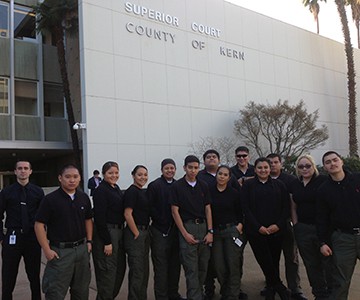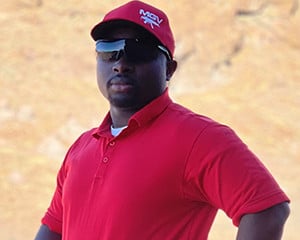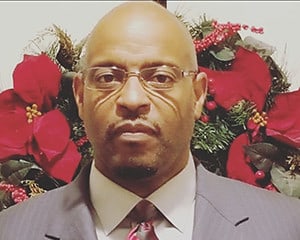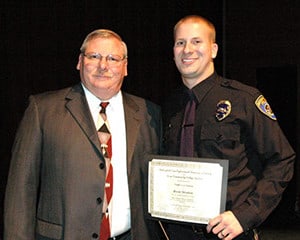Courtroom drama makes impression on Criminal Justice students
 “All rise” signals the beginning of what is usually an intense exchange of positions regarding a criminal charge brought forward. A defendant, lawyers for the defense and prosecution, a judge and sometimes a jury begin the legal process of discovering truth, responsibility and appropriate consequence.
“All rise” signals the beginning of what is usually an intense exchange of positions regarding a criminal charge brought forward. A defendant, lawyers for the defense and prosecution, a judge and sometimes a jury begin the legal process of discovering truth, responsibility and appropriate consequence.
Often, lives and futures hang in the balance.
Criminal Justice: Corrections students on the Bakersfield campus want to see how their careers might fit into these proceedings, as well as other aspects of the criminal justice system.
15 Criminal Justice students and instructor Bobby Stratton got up close and personal with this judicial dynamic in January when they spent a few hours at the Kern County Courthouse observing the process of two Superior court cases.
The first involved the preliminary hearing of someone accused of a fatal hit-and-run and driving while intoxicated, a felony charge. “In a preliminary hearing, the prosecution puts on a case for the judge to decide if there is enough information that a jury should hear it,” says Mr. Stratton.
“There is a good possibility that this man is going to prison, even though his victim was sitting in the middle of the road at the time,” says Stratton. “This experience personalizes it a little bit for the students. It puts a face on something that they have only read about in textbooks, or seen dramatized on TV.”
The students’ second courtroom experience was a jury trial in-progress, deciding the fate of a man accused of domestic violence. Criminal Justice students heard the testimony of the female victim as she described the assault. They also heard police testimony.
“It was intriguing to observe peace officers testify their side of the story,” says Jesse Valencia, Criminal Justice: Corrections student. “But what really caught our class’s attention was how the stories differed from one officer to another.”
This was a good teaching moment for Mr. Stratton’s class. “Students got to see how much information and detail the officers have to remember and the importance of report-writing,” he says. “It really drove the point home about being skilled at that ability.”
An unexpected highlight of the field trip was when the judge in the domestic violence case spent some time with SJVC students, explaining how the criminal justice system was at work that day.
“Having a member of the court explain to my students ‘what just happened’ was an unexpected highlight,” says Stratton, who recapped the judge’s stance. “He said that the whole idea is to protect the rights of the people, and to do what the laws says has to be done to protect the rights of the people.”
The preliminary hearing and jury trial witnessed that day by the Criminal Justice class coincided with their current class: Introduction to Criminal Justice. “This section talks about the process from arrest to conviction and incarceration,” says Stratton. It was valuable for his students to see the two primary steps of justice in action.
“It was interesting to see the difference between a preliminary (hearing) and a jury court,” says Jesse. “Overall, it was a fun experience to be able to witness this.”
This experience also gave Criminal Justice students a chance to spot potential career positions. “This shows them different positions that are out there and expands their ideas of what they might want to be,” says Stratton. “There are lab techs, detention officers, police service technicians, transportation officers and positions in the records office, property room and communication’s center.”
Learn More About A Career In Criminal Justice: Corrections
Criminal Justice: Corrections can open doors to work in private, state, federal prisons or local jails as well as in private security in California. Learn how to join this exciting career and why you should pursue a correctional officer degree.
You might also like
More stories about
Request Information
All fields using an asterik (*) are required.


